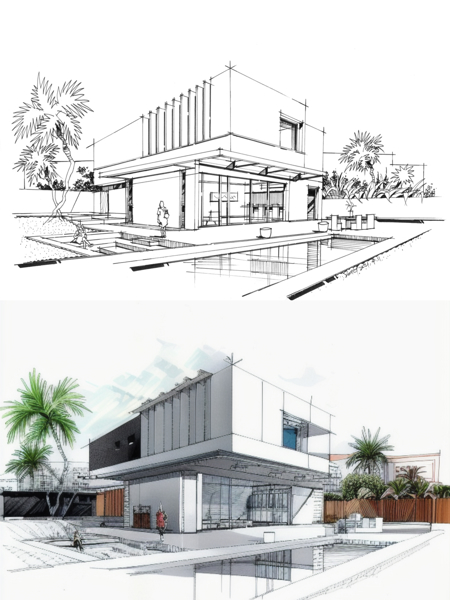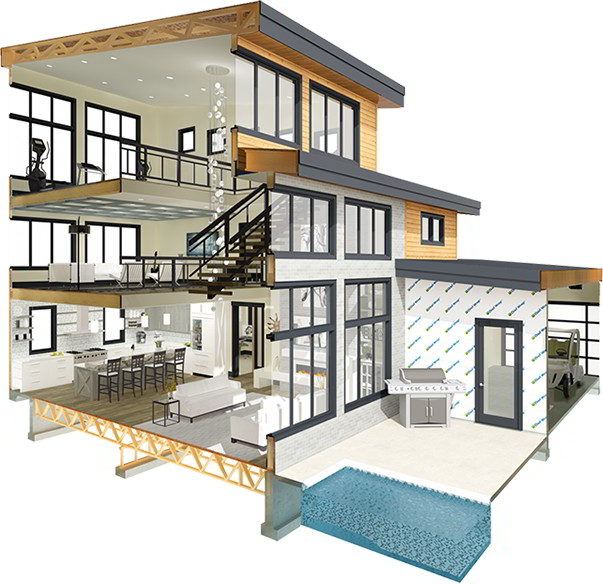The Impact of Technical Advancements on the Design Practices of Contemporary Architects
The fast advancement of technological devices has considerably reshaped the design landscape for modern architects, promoting unmatched levels of development and sustainability. The assimilation of Structure Information Modeling (BIM), parametric style, and fabricated intelligence has not only structured partnership amongst varied groups however likewise redefined job implementation. Nevertheless, as designers accept these advancements, they are challenged with intricate challenges that can affect their innovative processes. Checking out these characteristics reveals a nuanced interaction in between technology and standard layout methodologies, motivating a more detailed examination of what the future holds for building practices.
Development of Architectural Tools
Just how have building devices transformed the style and building and construction processes over the centuries? The evolution of building devices has actually considerably affected the efficiency, accuracy, and creative thinking of layout and building. In ancient times, engineers rely upon basic tools such as plumb bobs, gauging rods, and basic geometry to develop structures. These devices laid the foundation for early building technique, permitting for the building of legendary frameworks, albeit with limitations in accuracy and intricacy.
With the development of the Renaissance, the introduction of the compass and the protractor noted a pivotal shift. These tools enabled architects to accomplish better precision in their layouts, facilitating the appearance of more intricate and proportionate buildings (cda architects). The Industrial Change further transformed building method with the introduction of mechanical devices and products, enabling larger and much more ambitious projects
In the 20th century, the growth of computer-aided layout (CAD) software transformed the landscape once again, giving engineers with extraordinary capabilities in modeling and visualization. Today, progressed tools such as Structure Details Modeling (BIM) and parametric style software application remain to press the borders of architectural development, making it possible for an extra integrated approach to layout and building procedures.

Improved Cooperation in Design
As technology proceeds to evolve, boosted partnership in layout has ended up being a foundation of modern architectural practice. The assimilation of electronic devices such as Building Information Modeling (BIM), cloud-based platforms, and progressed visualization software has actually changed the way engineers, designers, and stakeholders communicate throughout the layout process. These tools assist in real-time communication, permitting teams to share concepts, adjustments, and comments instantaneously, no matter geographical area.
In addition, virtual reality (VR) and boosted reality (AR) have further enriched joint initiatives by enabling immersive experiences that allow clients and group participants to imagine tasks in an extra appealing way. This level of communication not only enhances understanding yet also promotes a feeling of possession among stakeholders, bring about more educated decision-making.
Additionally, interdisciplinary partnership has been streamlined with these technological advancements, enabling designers to work extra very closely with various other specialists, such as city coordinators and ecological professionals. The outcome is a much more natural method to develop that takes into consideration numerous perspectives and expertise. Ultimately, boosted partnership in layout is not just a pattern; it is crucial for developing innovative, useful, and aesthetically pleasing style in an increasingly complex globe.
Sustainability With Modern Technology
Sustainability in design has actually significantly become linked with technological innovation, driving the market toward eco responsible techniques - cda architects. Contemporary designers are leveraging advanced technologies to minimize ecological impact while enhancing the efficiency of structures. One noticeable example is making use of Building Info Modeling (BIM), which enables accurate preparation and resource allotment, decreasing waste during building and construction and promoting power efficiency throughout a structure's lifecycle
Additionally, clever materials and energy-efficient systems are being incorporated right into designs to optimize source use. Technologies such as solar cells and green roof harness renewable resource resources, adding to reduced carbon footprints. Furthermore, the application of synthetic knowledge in style processes makes it possible for engineers to imitate and analyze power usage, leading choices toward more lasting end results.
The integration of sustainable modern technologies not only straightens with worldwide ecological goals however additionally satisfies a boosting need from customers for environment-friendly remedies. As architects accept these innovations, the focus moves towards developing areas that are not only aesthetically pleasing but also functionally lasting, thus redefining the standards of contemporary design. This way, innovation offers as a driver for sustainability, enabling architects to make buildings that regard and improve the native environment.
Challenges in Implementation
While technical developments in design hold excellent pledge for enhancing sustainability, their implementation usually comes across considerable difficulties. One main barrier is the high learning contour linked with brand-new technologies. Architects and construction specialists might need substantial training to successfully make use of innovative software program and devices, which can postpone project timelines and increase expenses.
In addition, the combination of emerging innovations, such as Building Info Modeling (BIM) and lasting products, often demands collaboration throughout multidisciplinary teams. This collaboration can be prevented by distinctions in know-how, process, and interaction designs, causing possible conflicts and inefficiencies.
Financial constraints better complicate the fostering of innovative modern technologies. Lots of architectural companies, specifically smaller sized ones, may lack the sources to invest in advanced devices, limiting their ability to compete with larger companies that can manage such financial investments.
Moreover, regulative frameworks and building ordinance might not equal technological advancements, developing uncertainty and possible conformity concerns. This obstacle can inhibit designers from totally embracing brand-new technologies, as the threat of non-compliance might exceed the advantages. Consequently, resolving these implementation challenges is vital for the effective assimilation of technical advancements in contemporary architectural techniques.
Future Patterns in Style
The difficulties connected with the application of new innovations in style have actually motivated a reevaluation of future patterns within the market. As engineers browse problems such as sustainability, urbanization, and social equity, they are check here increasingly adopting ingenious innovations to improve style performance and ecological efficiency.
One prominent trend is the integration of artificial knowledge (AI) in the style process. AI devices can examine huge datasets to notify layout decisions, improving both creative page thinking and performance. Building Details Modeling (BIM) proceeds to advance, enabling real-time partnership among stakeholders and promoting streamlined project monitoring.
Lasting layout methods are likewise getting momentum, with engineers concentrating on flexible reuse and regenerative layout principles that reduce source usage and waste. The consolidation of clever materials and renewable resource sources will certainly better boost the durability of structures despite environment adjustment.
Furthermore, the surge of parametric layout permits more customized and context-sensitive architectural solutions. By using these advancements, architects are positioned to create constructed atmospheres that not only resolve the immediate needs of culture but also prepare for future obstacles, thereby redefining the role of style in an ever-changing globe.
Conclusion

Comments on “Top Reasons to Choose CDA Architects for Your Residential or Commercial Layouts”